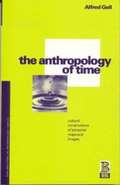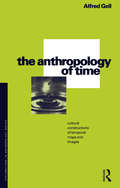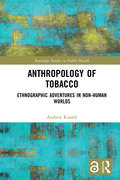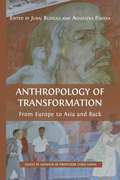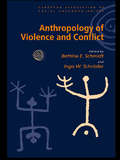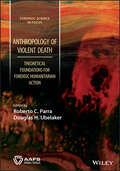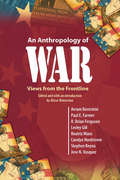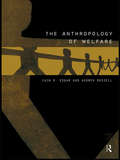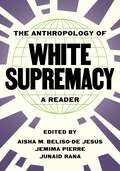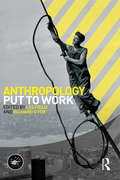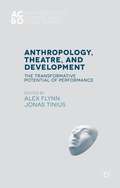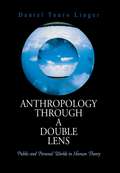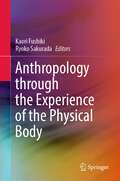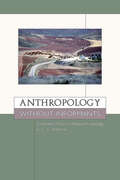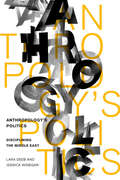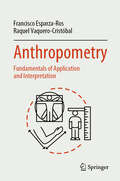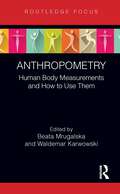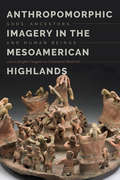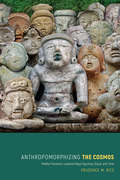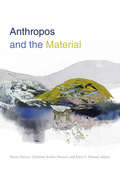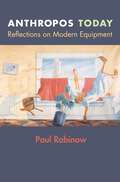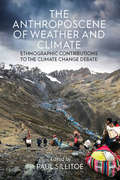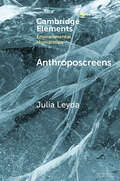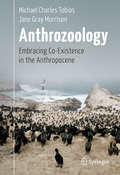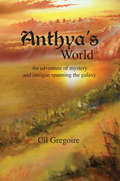- Table View
- List View
The Anthropology of Time: Cultural Constructions of Temporal Maps and Images (Explorations in Anthropology)
by Alfred GellHis discussion encompasses four main approaches in time research, namely developmental psychology, symbolic anthropology economic' theories of time in social geography and, finally, phenomenological theories. He concludes by presenting his own model of social/cognitive time, in the light of these critical discussions of the literature.
The Anthropology of Time: Cultural Constructions of Temporal Maps and Images (Explorations In Anthropology Ser. #47)
by Alfred GellTime - relentless, ever-present but intangible and the single element over which human beings have no absolute control - has long proved a puzzle. The author examines the phenomenon of time and asks such fascinating questions as how time impinges on people, to what extent our awareness of time is culturally conditioned, how societies deal with temporal problems and whether time can be considered a `resource' to be economized. More specifically, he provides a consistent and detailed analysis of theories put forward by a number of thinkers such as Durkheim, Evans-Pritchard, Lévi-Strauss, Geertz, Piaget, Husserl and Bourdieu. His discussion encompasses four main approaches in time research, namely developmental psychology, symbolic anthropology (covering the bulk of post-Durkheimian social anthropology) `economic' theories of time in social geography and, finally, phenomenological theories. The author concludes by presenting his own model of social/cognitive time, in the light of these critical discussions of the literature.
Anthropology of Tobacco [Open Access]: Ethnographic Adventures in Non-Human Worlds
by Andrew RussellTobacco has become one of the most widely used and traded commoditites on the planet. Reflecting contemporary anthropological interest in material culture studies, Anthropology of Tobacco makes the plant the centre of its own contentious, global story in which, instead of a passive commodity, tobacco becomes a powerful player in a global adventure involving people, corporations and public health. Bringing together a range of perspectives from the social and natural sciences as well as the arts and humanities, Anthropology of Tobacco weaves stories together from a range of historical, cross-cultural and literary sources and empirical research. These combine with contemporary anthropological theories of agency and cross-species relationships to offer fresh perspectives on how an apparently humble plant has progressed to world domination, and the consequences of it having done so. It also considers what needs to happen if, as some public health advocates would have it, we are seriously to imagine ‘a world without tobacco’. This book presents students, scholars and practitioners in anthropology, public health and social policy with unique and multiple perspectives on tobacco-human relations.
Anthropology of Transformation: From Europe to Asia and Back
by Juraj Buzalka and Agnieszka PasiekaThis collection of essays is the result of the joint efforts of colleagues and students of the leading social anthropology and post-socialism theorist, Professor Chris Hann. With the thirtieth anniversary of the collapse of the Berlin Wall in 2019 as their catalyst, the authors reflect upon Chris Hann’s lifelong fieldwork in the discipline, spanning regions as diverse as East Central Europe, Turkey, and the Chinese north-west.
Anthropology of Violence and Conflict (European Association of Social Anthropologists)
by Bettina E. Schmidt Ingo W. SchröderAnthropology of Violence has only recently developed into a field of research in its own right and as such it is still fairly fragmented. Anthropology of Violence and Conflict seeks to redress this fragmentation and develop a method of cross-cultural analysis. The study of important conflicts, such as wars in Sarajevo, Albania and Sri Lanka as well as numerous less publicised conflicts, all aim to create a theory of violence as cross-culturally applicable as possible. Most importantly this volume uses the anthropology of violence as a tool to help in the possible prevention of violence and conflict in the world today.
Anthropology of Violent Death: Theoretical Foundations for Forensic Humanitarian Action (Forensic Science in Focus)
by Roberto C ParraThe first book to specifically focus on the theoretical foundations of humanitarian forensic science Anthropology of Violent Death: Theoretical Foundations for Forensic Humanitarian Action consolidates the concepts and theories that are central to securing the posthumous dignity of the deceased, respecting their memories, and addressing the needs of the surviving populations affected. Focusing on the social and cultural significance of the deceased, this much-needed volume develops a theoretical framework that extends the role of humanitarian workers and specifically the actions of forensic scientists beyond an exclusively legal and technical approach. Anthropology of Violent Death is designed to inspire and alerts the scientific community, authorities, and the justice systems to think and take actions to avoid the moral injury in society and cultures due to grave disrespect against humanity, its memories and reconciliation. Humanitarian forensic science faces the role of mediator between the deceased and those who are still alive to guarantee the respect and dignity of humanity. Contributions from renowned experts address post-mortem dignity, cultural perceptions of violent death and various mortuary sites, the forms and critical effects of the so-called forensic turn and humanitarian action, the treatment of violent death in post-conflict societies, respect for the dead under International Humanitarian Law (IHL) and Islamic law, the ethical management of the death of migrants, and much more. In an increasingly violent world, this volume, develops a theoretical component for death management in scenarios where humanitarian action is required Facilities better understanding between the social sciences, the forensic sciences, and justice systems in situations involving violent death Discusses the latest theories from leading scholars and practitioners to enhance the activities of forensic scientists and authorities who have the difficult responsibility of making decisions It provides a better understanding of the humanitarian and cultural dilemmas in the face of violent death episodes, and the unresolved needs of the dignity of the deceased during armed conflicts, disasters, migration crises, including everyday homicides Anthropology of Violent Death: Theoretical Foundations for Forensic Humanitarian Action is an indispensable resource for forensic scientists, humanitarian workers, human rights defenders, and government and non-governmental officials.
An Anthropology Of War
by Alisse WaterstonAs we move deeper into the twenty-first century, power, lethal force, and injustice continue to explode violently into war, and the prospects for lasting peace look even bleaker. The horrors of modern warfare - the death, dehumanization, and destruction of social and material infrastructures - have done little to bring an end to armed conflict. In this volume, leading chroniclers of war provide thoughtful and powerful essays that reflect on their ethnographic work at the frontlines. The contributors recount not only what they have seen and heard in war zones but also what is being read, studied, analyzed and remembered in such diverse locations as Colombia and Guatemala, Israel and Palestine, Iraq, Afghanistan, and Haiti. In detailed reports from the field, they reflect on the important issue of "accountability" and offer explanations to discern causes, patterns, and practices of war. Through this unique lens, the contributors provide the insight and analysis needed for a deeper understanding of one of the greatest issues of our times. Contributors: Avram Bornstein, Paul E. Farmer, R. Brian Ferguson, Lesley Gill, Beatriz Manz, Carolyn Nordstrom, Stephen Reyna, Jose N. Vasquez
The Anthropology of Welfare
by Iain R. Edgar Andrew RussellThe Anthropology of Welfare provides an overview of what anthropology has to offer welfare studies and vice-versa. Case studies from anthropologists in the field, examine different branches of welfare and community care, for example: * Maternity services * Children with learning difficulties * Children's homes * Mothers' centres * People with HIV * Mental health centres * Housing * Care and provision for the elderly. Contributors focus on comparative welfare systems - examples are taken from urban and rural areas of the UK, USA, Sweden, Germany, Portugal, and New Zealand. In each case the theoretical and methodological appropriateness of social anthropology for the study of welfare, and the insights gained by bringing anthropology and welfare together are examined. The Anthropology of Welfare will be essential reading for those studying anthropology, social work and social policy and will be of interest to teachers, practitioners and researchers in applied social welfare fields.
The Anthropology of White Supremacy: A Reader
by Aisha M. Beliso-De Jesús, Jemima Pierre, and Junaid RanaAn anthology of original essays that examine white supremacy around the globe through the lens of anthropologyWhite supremacy, an entrenched global system that emerged alongside European colonialism, is based on presumed biological and cultural differences, racist practices, the hypervaluation of whiteness, and the devaluation of nonwhites. Anthropology has been shaped by—and has helped to shape—white supremacy, yet the discipline also offers powerful tools for understanding this system at a global scale. The Anthropology of White Supremacy gathers original essays from a diverse, international group of anthropologists to explore how this phenomenon works both within anthropology and in cultural and political structures around the world.The book features historical and ethnographic analysis about Brazil, Iceland, Japan, Mexico, Nigeria, Palestine, Senegal, South Africa, and the United States, and addresses the ways white supremacy impacts a broad range of issues, including finance, advertising and media representations, militarism, police training, migration, and development.The Anthropology of White Supremacy demonstrates not only how anthropology can help us to better comprehend white supremacy, but also how the discipline can help us begin to dismantle it.The contributors include Omolade Adunbi, Samar Al-Bulushi, Aisha M. Beliso-De Jesús, Michael L. Blakey, Mitzi Uehara Carter, Subhadra Mitra Channa, Celina de Sá, Vanessa Díaz, Britt Halvorson, Faye V. Harrison, Sarah Ihmoud, Anthony R. Jerry, Darryl Li, Kristín Loftsdóttir, Christopher A. Loperena, Keisha-Khan Y. Perry, Jemima Pierre, Jean Muteba Rahier, Laurence Ralph, Renya K. Ramirez, Junaid Rana, Joshua Reno, Rhea Rahman, Jonathan Rosa, Shalini Shankar, Shannon Speed, and Maria Dyveke Styve.
Anthropology Put to Work (Wenner-Gren International Symposium Series)
by Les W. Field Richard G. FoxHow do anthropologists work today and how will they work in future? While some anthropologists have recently called for a new "public" or "engaged" anthropology, profound changes have already occurred, leading to new kinds of work for a large number of anthropologists. The image of anthropologists "reaching out" from protected academic positions to a vaguely defined "public" is out of touch with the working conditions of these anthropologists, especially those junior and untenured. The papers in this volume show that anthropology is put to work in diverse ways today. They indicate that the new conditions of anthropological work require significant departures from canonical principles of cultural anthropology, such as replacing ethnographic rapport with multiple forms of collaboration. This volume's goal is to help graduate students and early-career scholars accept these changes without feeling something essential to anthropology has been lost. There really is no other choice for most young anthropologists.
Anthropology, Theatre, and Development
by Alex Flynn Jonas TiniusFrom Pussy Riot and the Arab Spring to Italian mafia dance, this collection provides an interdisciplinary analysis of relational reflexivity in political performance. By putting anthropological theory into dialogue with international development scholarship and artistic and activist practices, this book highlights how aesthetics and politics interrelate in precarious spheres of social life. The contributors of this innovative interdisciplinary volume raise questions about the transformativepotential of participating in and reflecting upon political performances both as individual and as collectives. They also argue that such processes provide a rich field and new pathways for anthropological explorations of peoples' own reflections on humanity, sociality, change, and aspiration. Reflecting on political transformations through performance puts centre stage the ethical dimensions of cultural politics and how we enact political subjectivity.
Anthropology Through a Double Lens
by Daniel Touro LingerHow can we hold both public and personal worlds in the eye of a unified theory of meaning? What ethnographic and theoretical possibilities do we create in the balance? Anthropology Through a Double Lens offers a theoretical framework encompassing both of these domains--a "double lens." Daniel Touro Linger argues that the literary turn in anthropology, which treats culture as text, has been a wrong turn. Cultural analysis of the interpretive or discursive variety, which focuses on public symbols, has difficulty seeing--much less dealing convincingly with--actual persons. While emphasizing the importance of social environments, Linger insists on equal sensitivity to the experiential immediacies of human lives. He develops a sustained critique of interpretive and discursive trends in contemporary anthropology, which have too strongly emphasized social determinism and public symbols while too readily dismissing psychological and biographical realities.Anthropology Through a Double Lens demonstrates the power of an alternative dual perspective through a blend of critical essays and ethnographic studies drawn from the author's field research in São Luís, a northeastern Brazilian state capital, and Toyota City, a Japanese factory town. To span the gap between the public and the personal, Linger provides a set of analytical tools that include the ideas of an arena of meaning, systems of systems, bridging theory, singular lives, and reflective consciousness. The tools open theoretical and ethnographic horizons for exploring the process of meaning-making, the force of symbolism and rhetoric, the politics of representation, and the propagation and formation of identities. Linger uses these tools to focus on key issues in current theoretical and philosophical debates across a host of disciplines, including anthropology, psychology, history, and the other human sciences..
Anthropology through the Experience of the Physical Body
by Kaori Fushiki Ryoko SakuradaThis book seeks to break new ground, both empirically and conceptually, in examining changing understandings of the physical human body from a variety of anthropological perspectives. In doing so, it interrogates how the body has been and continues to be conceptualised, experienced and interacted with. After an introductory appraisal of recent approaches to understanding the body, the book provides empirically rich accounts from East and Southeast Asia of how cultural, environmental and social norms shape human physicality. The contributions are organised in four broad themes. Part I, ‘Body and Space’, offers two contrasting case studies from Malaysia, both of which examine gender norms associated with marriage and pregnancy, including the taboos associated with these rites of passage. Part II, ‘Imperfect Bodies: Communication and the Body as Media’, analyses two case studies—Deaf people in Japan and masked theatre performance in Bali, Indonesia, to reflect on changing attitudes towards disability, which reflect broader social norms and cultural beliefs about the nature of disability and its place in society. Part III, ‘The Body and Image’, provides a pair of case studies from Singapore, on male fans of the popular manga boys’ love genre and on ways that the Chinese zodiac system is determined from birth and continues to be spiritually embedded in the body of a Chinese individual through ritual practices. Part IV, ‘The Body as Container: Taming the Bodies?’, presents a single case study from Thailand of spirit possession among schoolchildren. Though wide-ranging, all the case studies posit that the body is a site of constant negotiation. The way the body is presented and the way it is seen are shaped by a complex array of social, cultural, political and ideational factors. Anthropology through the Experience of the Physical Body is a valuable interdisciplinary work for advanced students and researchers interested in representations of the body in East and Southeast Asia and for those with wider interests in the field of critical anthropology.
Anthropology without Informants: Collected Works in Paleoanthropology by L.G. Freeman
by L. G. FreemanL.G. Freeman is a major scholar of Old World Paleolithic prehistory and a self-described “behavioral paleoanthropologist.” Anthropology without Informants is a collection of previously published papers by this preeminent archaeologist, representing a cross section of his contributions to Old Work Paleolithic prehistory and archaeological theory. A socio-cultural anthropologist who became a behavioral paleoanthropologist late in his career, Freeman took a unique approach, employing statistical or mathematical techniques in his analysis of archaeological data. All the papers in this collection blend theoretical statements with the archeological facts they are intended to help the reader understand. Although he taught at the University of Chicago for the span of his 40-year career, Freeman is not well-known among Anglophone scholars, because his primary fieldwork and publishing occurred in Cantabrian, Spain. However, he has been a major player in Paleolithic prehistory, and this volume will introduce his work to more American Archaeologists. This collection brings the work of an expert scholar, to a broad audience, and will be of interest to archaeologists, their students, and lay readers interested in the Paleolithic era.
Anthropology's Politics: Disciplining the Middle East
by Jessica Winegar Lara DeebU. S. involvement in the Middle East has brought the region into the media spotlight and made it a hot topic in American college classrooms. At the same time, anthropology--a discipline committed to on-the-ground research about everyday lives and social worlds--has increasingly been criticized as "useless" or "biased" by right-wing forces. What happens when the two concerns meet, when such accusations target the researchers and research of a region so central to U. S. military interests? This book is the first academic study to shed critical light on the political and economic pressures that shape how U. S. scholars research and teach about the Middle East. Lara Deeb and Jessica Winegar show how Middle East politics and U. S. gender and race hierarchies affect scholars across their careers--from the first decisions to conduct research in the tumultuous region, to ongoing politicized pressures from colleagues, students, and outside groups, to hurdles in sharing expertise with the public. They detail how academia, even within anthropology, an assumed "liberal" discipline, is infused with sexism, racism, Islamophobia, and Zionist obstruction of any criticism of the Israeli state. Anthropology's Politics offers a complex portrait of how academic politics ultimately hinders the education of U. S. students and potentially limits the public's access to critical knowledge about the Middle East.
Anthropometry: Fundamentals of Application and Interpretation
by Francisco Esparza-Ros Raquel Vaquero-CristóbalThe science of Anthropometry is gaining an increasing number of followers, as it allows for a valid, reliable and cheap assessment of body composition and other interesting variables from the point of view of health and sport. However, not many books have addressed the anthropometric technique from its foundations. This book deals with issues to consider during an anthropometric assessment, such as the physical approach to the subject during the anthropometric assessment, or the factors to consider so that the data obtained are valid and reliable. It also clearly and concisely addresses the approach to body composition with anthropometry, what somatotype is, and how it is interpreted, and how anthropometry can be used to obtain proportionality values, which are very useful for the detection of sporting talents. Finally, the application of anthropometry in two of the fields where anthropometry is most used: the field of sport from the basics to elite sport, and health. All of this is conducted under the perspective of two of the world's leading experts in kinanthropometry, with the goal for the reader to acquire knowledge on every aspect of anthropometry, from the basics to in-depth knowledge of this science.
Anthropometry: Human Body Measurements and How to Use Them (Body of Knowledge in Human Factors and Ergonomics)
by Beata Mrugalska Waldemar KarwowskiToday, human factors and ergonomics professionals worldwide contribute to the design and evaluation of tasks, jobs, products, environments, and systems in order to make them compatible with the needs, abilities, and limitations of people. By understanding anthropometry, professionals can ensure that our home and working environments are comfortable and designed with the human in mind. This book aims to show how an understanding of anthropometrics can influence workspace design, ergonomics in the office, ergonomics in the home, and health and safety at work. This book discusses the measurement of the human body and human variability. Anthropometry may seem to be relatively simple but the reality is that it focuses on very sophisticated aspects of how to make the products tailor-made to suit specific requirements. As a study, it is useful for a variety of purposes such as workspace design, ergonomics in the office, ergonomics in the home, and health and safety at work. These eleven chapters investigate anthropometrics and bridge the gap between theory and practice. Each chapter is supported by tables, charts, and illustrations, and a wide list of bibliographic references. The reader will develop new insights into the principles and practice of anthropometrics with this book bringing the topic right up to date. Anthropometry: Human Body Measurements and How to Use Them will be of interest to students, graduates, teachers, researchers, and general workers in industrial design, ergonomics, rehabilitation, safety, and health.
Anthropomorphic Imagery in the Mesoamerican Highlands: Gods, Ancestors, and Human Beings
by Brigitte Faugère Christopher BeekmanIn Anthropomorphic Imagery in the Mesoamerican Highlands, Latin American, North American, and European researchers explore the meanings and functions of two- and three-dimensional human representations in the Precolumbian communities of the Mexican highlands. Reading these anthropomorphic representations from an ontological perspective, the contributors demonstrate the rich potential of anthropomorphic imagery to elucidate personhood, conceptions of the body, and the relationship of human beings to other entities, nature, and the cosmos. Using case studies covering a broad span of highlands prehistory—Classic Teotihuacan divine iconography, ceramic figures in Late Formative West Mexico, Epiclassic Puebla-Tlaxcala costumed figurines, earth sculptures in Prehispanic Oaxaca, Early Postclassic Tula symbolic burials, Late Postclassic representations of Aztec Kings, and more—contributors examine both Mesoamerican representations of the body in changing social, political, and economic conditions and the multivalent emic meanings of these representations. They explore the technology of artifact production, the body’s place in social structures and rituals, the language of the body as expressed in postures and gestures, hybrid and transformative combinations of human and animal bodies, bodily representations of social categories, body modification, and the significance of portable and fixed representations. Anthropomorphic Imagery in the Mesoamerican Highlands provides a wide range of insights into Mesoamerican concepts of personhood and identity, the constitution of the human body, and human relationships with gods and ancestors. It will be of great value to students and scholars of the archaeology and art history of Mexico. Contributors: Claire Billard, Danièle Dehouve, Cynthia Kristan-Graham, Melissa Logan, Sylvie Peperstraete, Patricia Plunket, Mari Carmen Serra Puche, Juliette Testard, Andrew Turner, Gabriela Uruñuela, Marcus Winter
Anthropomorphizing the Cosmos: Middle Preclassic Lowland Maya Figurines, Ritual, and Time
by Prudence M. RiceAnthropomorphizing the Cosmos explores the sociocultural significance of more than three hundred Middle Preclassic Maya figurines uncovered at the site of Nixtun-Ch'ich' on Lake Petén Itzá in northern Guatemala. In this careful, holistic, and detailed analysis of the Petén lakes figurines—hand-modeled, terracotta anthropomorphic fragments, animal figures, and musical instruments such as whistles and ocarinas—Prudence M. Rice engages with a broad swath of theory and comparative data on Maya ritual practice. Presenting original data, Anthropomorphizing the Cosmos offers insight into the synchronous appearance of fired-clay figurines with the emergence of societal complexity in and beyond Mesoamerica. Rice situates these Preclassic Maya figurines in the broader context of Mesoamerican human figural representation, identifies possible connections between anthropomorphic figurine heads and the origins of calendrics and other writing in Mesoamerica, and examines the role of anthropomorphic figurines and zoomorphic musical instruments in Preclassic Maya ritual. The volume shows how community rituals involving the figurines helped to mitigate the uncertainties of societal transitions, including the beginnings of settled agricultural life, the emergence of social differentiation and inequalities, and the centralization of political power and decision-making in the Petén lowlands. Literature on Maya ritual, cosmology, and specialized artifacts has traditionally focused on the Classic period, with little research centering on the very beginnings of Maya sociopolitical organization and ideological beliefs in the Middle Preclassic. Anthropomorphizing the Cosmos is a welcome contribution to the understanding of the earliest Maya and will be significant to Mayanists and Mesoamericanists as well as nonspecialists with interest in these early figurines
Anthropos and the Material
by Penny Harvey Christian Krohn-Hansen Knut G. NustadThe destructive effects of modern industrial societies have shaped the planet in such profound ways that many argue for the existence of a new geological epoch called the Anthropocene. This claim brings into relief a set of challenges that have deep implications for how relations between the human, the material, and the political affect contemporary social worlds. The contributors to Anthropos and the Material examine these challenges by questioning and complicating long-held understandings of the divide between humans and things. They present ethnographic case studies from across the globe, addressing myriad topics that range from labor, economics, and colonialism to technology, culture, the environment, agency, and diversity. In foregrounding the importance of connecting natural and social histories, the instability and intangibility of the material, and the ways in which the lively encounters between the human and the nonhuman challenge conceptions of liberal humanism, the contributors point to new understandings of the capacities of people and things to act, transform, and adapt to a changing world.
Anthropos Today: Reflections on Modern Equipment (In-Formation)
by Paul RabinowThe discipline of anthropology is, at its best, characterized by turbulence, self-examination, and inventiveness. In recent decades, new thinking and practice within the field has certainly reflected this pattern, as shown for example by numerous fruitful ventures into the "politics and poetics" of anthropology. Surprisingly little attention, however, has been given to the simple insight that anthropology is composed of claims, whether tacit or explicit, about anthropos and about logos--and the myriad ways in which these two Greek nouns have been, might be, and should be, connected. Anthropos Today represents a pathbreaking effort to fill this gap. Paul Rabinow brings together years of distinguished work in this magisterial volume that seeks to reinvigorate the human sciences. Specifically, he assembles a set of conceptual tools--"modern equipment"--to assess how intellectual work is currently conducted and how it might change. Anthropos Today crystallizes Rabinow's previous ethnographic inquiries into the production of truth about life in the world of biotechnology and genome mapping (and his invention of new ways of practicing this pursuit), and his findings on how new practices of life, labor, and language have emerged and been institutionalized. Here, Rabinow steps back from empirical research in order to reflect on the conceptual and ethical resources available today to conduct such inquiries. Drawing richly on Foucault and many other thinkers including Weber and Dewey, Rabinow concludes that a "contingent practice" must be developed that focuses on "events of problematization." Brilliantly synthesizing insights from American, French, and German traditions, he offers a lucid, deeply learned, original discussion of how one might best think about anthropos today.
The Anthroposcene of Weather and Climate: Ethnographic Contributions to the Climate Change Debate
by Paul SillitoeWhile it is widely acknowledged that climate change is among the greatest global challenges of our times, it has local implications too. This volume forefronts these local issues, giving anthropology a voice in this great debate, which is otherwise dominated by natural scientists and policy makers. It shows what an ethnographic focus can offer in furthering our understanding of the lived realities of climate debates. Contributors from communities around the world discuss local knowledge of, and responses to, environmental changes that need to feature in scientifically framed policies regarding mitigation and adaptation measures if they are to be effective.
Anthroposcreens: Mediating the Climate Unconscious (Elements in Environmental Humanities)
by Julia LeydaAnthroposcreens frames the 'climate unconscious' as a reading strategy for film and television productions during the Anthropocene. Drawing attention to the affects of climate change and the broader environmental damage of the Anthropocene, this study mobilizes its frame in concert with other tools from cultural and film studies—such as debates over Black representation—to provide readings of the underlying environmental themes in Black American and Norwegian screen texts. These bodies of work provide a useful counterpoint to the dominance of white Anglo-American stories in cli-fi while also ranging beyond the boundaries of the cli-fi genre to show how the climate unconscious lens functions in a broader set of texts. Working across film studies, cultural studies, Black studies, and the environmental humanities, Anthroposcreens establishes a cross-disciplinary reading strategy of the 'climate unconscious' for contemporary film and television productions. This title is also available as Open Access on Cambridge Core.
Anthrozoology: Embracing Co-Existence in the Anthropocene
by Michael Charles Tobias Jane Gray MorrisonThis groundbreaking work of both theoretical and experiential thought by two leading ecological philosophers and animal liberation scientists ventures into a new frontier of applied ethical anthrozoological studies. Through lean and elegant text, readers will learn that human interconnections with other species and ecosystems are severely endangered precisely because we lack - by our evolutionary self-confidence - the very coherence that is everywhere around us abundantly demonstrated. What our species has deemed to be superior is, according to Tobias and Morrison, the cumulative result of a tragically tenuous argument predicated on the brink of our species' self-destruction, giving rise to a most unique proposition: We either recognize the miracle of other sentient intelligence, sophistication, and genius, or risk enshrining the shortest lived epitaph of any known vertebrate in earth's 4. 1 billion years of life. Tobias and Morrison draw on 45 years of research in fields ranging from ecological anthropology, animal protection and comparative ethics to literature and spirituality - and beyond. They deploy research in animal and plant behavior, biocultural heritage contexts from every continent and they bring to bear a deeply metaphysical array of perspectives that set this book apart from any other. The book departs from most work in such fields as animal rights, ecological aesthetics, comparative ethology or traditional animal and plant behaviorist work, and yet it speaks to readers with an interest in those fields. A deeply provocative book of philosophical premises and hypotheses from two of the world's most influential ecological philosophers, this text is likely to stir uneasiness and debate for many decades to come.
Anthya's World: An adventure of mystery and intrigue spanning the galaxy
by Cil GregoireDroclum is dead, but artifacts of his evil remain. Rahlys and a chosen few of her warriors join Anthya and Quaylyn on an expedition to the Devastated Continent, to search for the seven members of the lost expedition, and to explore the island continent, transformed by the catastrophic eruption of Mt. Vatre. Meanwhile back on Earth, Vince and Maggie are immersed in unique challenges of their own. Anthya's World intricately weaves a powerful tale that spans from Alaska's North Slope and Upper Susitna Valley to a world across the Milky Way Galaxy.
